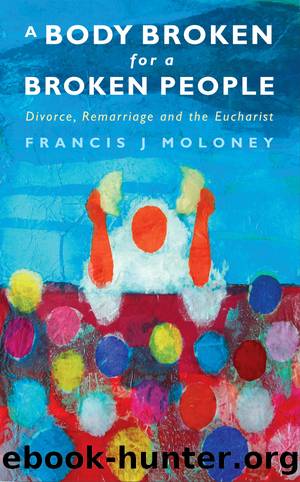A Body Broken for a Broken People by Moloney Francis J.;

Author:Moloney, Francis J.;
Language: eng
Format: epub
Publisher: Darton, Longman & Todd LTD
Published: 2015-10-02T00:00:00+00:00
THE JOURNEY TO EMMAUSâAND THE RETURN TO JERUSALEM
The Gospels of Mark and Matthew both promise the reconstitution of a disbanded and failed group of disciples âon the other sideâ of Jesusâ death and resurrection. They do this within the context of the Last Supper: âI shall not drink again of the fruit of the vine, until that day when I drink it new in the kingdom of Godâ (Mark 14:25; Matt 26:29). Neither Mark nor Matthew reports a scene after the resurrection where this promise is fulfilled. It was not needed as the prophecy points to the actual celebration of the Eucharist as it was practiced in both the Markan and the Matthean communities.
In the Gospel of Luke, Jesus makes such a prediction on two occasions (Luke 22:16 and 18). Luke, however, goes further than either Mark or Matthew by reporting two occasions when the risen Jesus shares a meal with his disciples. The first of these meal scenes is recorded in Luke 24:13-35: the journey to Emmaus. All the episodes of the resurrection account are linked by an insistence that everything took place on the one day. The account opens with the naming of a given day: âOn the first day of the weekâ (24:1). The reader is next told, âThat very same day two of them were going to a village named Emmausâ (v. 13). Toward the end of their journey, Jesusâ fellow-travelers say: âStay with us for it is towards evening and the day is now far spentâ (v. 29). After the breaking of the bread, âThey rose that same hour and returned to Jerusalem.â They make their report, but âas they were saying this, Jesus himself stood among themâ (v. 36). This is the final presence of Jesus to his disciples in the Gospel (see v. 51, where he leaves them).
The whole of Lukeâs Gospel has been directed toward this âday.â As Jesus began his journey toward Jerusalem in 9:51, the narrator commented, âWhen the days drew near for him to be received up, he set his face to go to Jerusalem.â That âjourneyâ comes to its close in Jerusalem through âthe things that have happened thereâ (24:18). On this resurrection âdayâ we sense that we are at the end of a long journey. In fact, one of the most important themes of the Gospel of Luke and its companion work, the Acts of the Apostles, is the theme of a journey.59 Throughout the Gospel, a journey leads to Jerusalem, where the paschal events take place (see especially 9:51). At the beginning of Acts, the early Church is still in Jerusalem. The Spirit is given there, and it is from there that a second journey begins, reaching out to the ends of the earth.60 The center-point of Lukeâ Acts is the city of Jerusalem. The journey of Jesus leads him there. In Jerusalem the Paschal events take place, and he ascends to his Father from that city. Jerusalem is the end of the journey of Jesus; the journey of the apostles begins there.
Download
This site does not store any files on its server. We only index and link to content provided by other sites. Please contact the content providers to delete copyright contents if any and email us, we'll remove relevant links or contents immediately.
Infants and Children in the Church by Harwood Adam;Lawson Kevin E.; & Kevin E. Lawson(261)
Chemical industries exposition by Unknown(247)
On The Spirit And The Letter by Saint Augustine - St. Augustine(168)
On Christian Doctrine by St. Augustine(166)
The Portable Seminary by David Horton(140)
Silk Road Traces: Studies on Syriac Christianity in China and Central Asia by LIT Verlag(120)
The Work of Theology by Hauerwas Stanley;(120)
Keep Calm And Do Your Job 02 by Unknown(110)
grand prix circus manual by Unknown(106)
Pain That Heals by Martin Israel(101)
Urban Legend by Jonathan Green(99)
The Hidden History of Jesus and the Holy Grail by Laurence Gardner(94)
manual-es-2.6 by Unknown(91)
Discovering the Spirit in the City by Andrew Walker; Aaron Kennedy; Aaron Kennedy(87)
God Is Impassible and Impassioned by Rob Lister(86)
A Body Broken for a Broken People by Moloney Francis J.;(86)
The Ironic Christian's Companion by Patrick Henry(85)
In Search of a Non-Dogmatic Theology by Jeffrey W. Robbins(84)
Confession and Politics in the Principality of Transylvania 1644â1657 (9783666540790) by Unknown(80)
